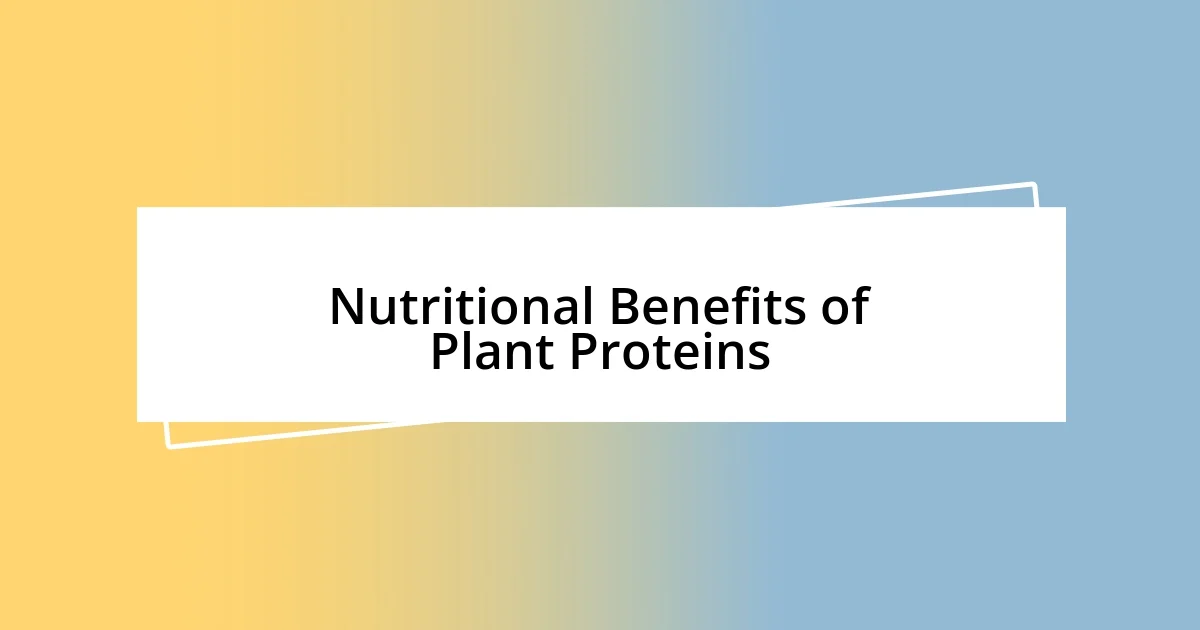Key takeaways:
- Plant-based proteins, such as lentils, chickpeas, and quinoa, offer rich nutritional benefits, including high fiber content and lower saturated fats, contributing to overall health and vitality.
- Combining different plant protein sources can create a complete amino acid profile, making them effective for muscle building and satisfying hunger without relying on animal proteins.
- Incorporating plant proteins into meals through variety, meal prep, and creative recipes can enhance culinary experiences while being mindful of personal health and environmental impact.

Understanding Plant-Based Protein Sources
When I first explored the realm of plant-based proteins, I was surprised by the sheer variety available. From lentils and chickpeas to quinoa and hemp seeds, each source not only packs a protein punch but also brings its own unique flavor and texture. Have you ever tried using lentils in a stew? It adds a hearty feel that makes the dish comfortingly robust.
I remember my initial attempt at making a chickpea salad; the experience was a delicious revelation. The nutty flavor combined with fresh veggies and a zesty dressing transformed my view on salads entirely. Each bite was a reminder that plant proteins can be just as satisfying as their animal-based counterparts. This led me to realize that understanding how to incorporate these sources into my meals can truly elevate my culinary experiences.
It’s fascinating to consider how tofu and tempeh, both derived from soy, serve as fantastic substitutes in recipes traditionally centered around meat. Have you noticed how versatile tofu is? I often find myself marinating and grilling it, and it soaks up flavors beautifully. This adaptability makes exploring plant-based proteins a continually evolving adventure in my kitchen.

Nutritional Benefits of Plant Proteins
Switching to plant proteins has been an enlightening journey, especially when I learned about their rich nutritional benefits. One prominent advantage is their high fiber content. I recall the first time I added black beans to my homemade chili. Not only did it boost the protein, but I was also pleasantly surprised by how filling it was, which kept me satisfied for hours without that sluggish feeling often associated with heavier meals.
Nutritional Benefits of Plant Proteins:
– Rich in Fiber: Promotes digestive health and helps maintain a healthy weight.
– Lower in Saturated Fats: This contributes to heart health and reduces the risk of chronic diseases.
– Packed with Vitamins and Minerals: Plant proteins often come with a host of essential nutrients, enhancing overall wellness.
– Antioxidants: Many sources of plant protein are rich in antioxidants, which protect our cells from damage.
– Alkalizing Effects: They can help balance body pH levels, contributing to overall health.
I’ve noticed these benefits firsthand; for instance, my energy levels soared after I replaced a meat-heavy dish with a lentil curry. Eating clean, colorful meals didn’t just make me feel lighter, but it infused my days with a renewed sense of vitality. Every scoop of vibrant quinoa now feels like a gift to my body, reminding me that fueling myself with plant-based proteins is not just nutritious—it’s a delightful experience.

Comparing Plant and Animal Proteins
While both plant and animal proteins are important, their nutritional profiles differ significantly. Animal proteins, like chicken and beef, offer complete proteins, meaning they contain all essential amino acids our bodies can’t produce on their own. I remember feeling satisfied after a hearty beef stew, knowing I was getting a robust protein source. In contrast, most plant proteins are considered incomplete, which means combining different sources—like beans and rice—can ensure a full amino acid profile. It’s a bit of a puzzle, but I’ve found it somewhat enjoyable to explore these combinations in my meals.
Another interesting aspect is the way these proteins impact our health. Animal proteins can often come with saturated fats, which I’ve learned can contribute to higher cholesterol levels. This realization hit home during a routine medical check-up when I learned my cholesterol was slightly elevated. Since then, I’ve made a conscious effort to reduce saturated fats in my diet, opting more for plant-based sources like lentils and quinoa that offer heart-healthy benefits. Not only do I feel better, but incorporating more plant proteins into my diet has shifted my culinary horizon.
Finally, the environmental impact of our protein choices can’t be ignored. Animal farming is resource-intensive and contributes significantly to greenhouse gas emissions, whereas plant proteins have a much lower environmental footprint. After reading about this, I began to feel a deeper connection to my food choices. When I prepare a refreshing chickpea tabbouleh, it’s not just about taste; it’s about contributing positively to the planet. I believe that every meal is an opportunity to be mindful of our impact, and plant proteins offer a satisfying way to embrace that philosophy.
| Aspect | Plant Protein | Animal Protein |
|---|---|---|
| Amino Acids | Incomplete (often need to be combined) | Complete (contains all essential amino acids) |
| Saturated Fats | Lower levels | Higher levels |
| Health Benefits | High in fiber, antioxidants | Rich in vitamins, minerals |
| Environmental Impact | Lower carbon footprint | Higher resource demand |

How to Incorporate Plant Proteins
When it comes to incorporating plant proteins into my meals, I often start by swapping out traditional protein sources for legumes. One of my favorite meals has become a lentil salad. I toss in some fresh veggies, a splash of olive oil, and just a hint of lemon juice. It’s refreshing, filling, and I can’t help but smile every time I think about how easy it is to pack in so much nutrition. Have you ever noticed how colorful ingredients can enhance your mood?
Moreover, I’ve found that blending plant proteins into my breakfast routine makes a significant difference. Adding a scoop of pea protein powder to my morning smoothie not only boosts my protein intake, but I also get the delightful satisfaction of feeling energized for the day ahead. It’s thoughtful little touches like this that turn an ordinary meal into something exciting. Isn’t it amazing how simple changes can lead to big benefits?
On those busy days when time is a luxury, I lean towards quick and easy plant-based options like edamame or chickpea snacks. Crunching on roasted chickpeas in the afternoon lifts my spirits and keeps my hunger at bay. Have you tried them? They’re like nature’s little energy bites, reminding me that making healthier choices doesn’t have to be complicated. With the right approach, incorporating plant proteins into my daily life feels less like a chore and more like an adventure.

Recipes Rich in Plant Proteins
I genuinely enjoy experimenting with plant-based protein recipes, and one dish that never fails to impress is a hearty black bean chili. The rich flavors of cumin and smoked paprika mix perfectly with the tender beans, creating a comforting bowl that warms both body and soul. I often invite friends over for a chili night, and it’s rewarding to see everyone savoring a dish packed with plant protein while sharing stories around the table. What do you like to cook when you have company?
Another favorite of mine is a quinoa-stuffed bell pepper. I stuff vibrant peppers with a mixture of quinoa, corn, and spices, which not only looks beautiful but also delivers a protein punch. Each bite is a delightful blend of textures; it feels satisfying knowing I’m nourishing my body with wholesome ingredients. I remember the first time I served this dish at a family gathering, and my aunt, who usually favors meat, couldn’t help but go back for seconds. Isn’t it incredible how plant-based meals can surprise even the most traditional eaters?
For something sweet, I love whipping up a batch of chocolate chickpea brownies. Yes, you read that right—chickpeas in brownies! They add moisture and protein without compromising flavor. The first time I made these, my skeptical partner ended up devouring half the batch. I’d say it’s a delightful revelation when you realize that healthy recipes can bring joy and satisfaction. Who wouldn’t crave a dessert that’s both indulgent and nutrient-rich?

Common Misconceptions About Plant Proteins
One common misconception I’ve encountered is that plant proteins lack essential amino acids. This stems from the idea that animal proteins are superior, but the truth is, many plant-based options, like quinoa and soy, provide a complete amino acid profile. When I first started eating more plant proteins, I was surprised to learn that combinations like rice and beans can offer the full spectrum of these vital building blocks. Have you ever thought you needed to eat meat to get enough amino acids?
Another frequent myth is that plant proteins aren’t as effective for building muscle. I used to believe this and worried about my protein intake when I transitioned to a plant-based diet. However, I’ve discovered that with the right sources, such as lentils and hemp seeds, you can easily meet your protein needs and see the same muscle gains. In fact, I felt stronger than ever when I switched to a more plant-focused diet. Isn’t it empowering to realize that you can thrive on a different approach?
People often think that plant proteins aren’t filling enough to satisfy hunger. I’ve personally battled with this mindset, but incorporating hearty options like chickpeas or black beans into my meals has changed everything. Their fiber content keeps me feeling full and satisfied for hours. I remember one evening when I prepared a chickpea curry that left me feeling nourished rather than heavy. Have you ever tried a plant protein dish that completely transformed your perception?

Tips for Balancing Your Diet
When it comes to balancing a plant-based diet, variety really is the spice of life. I’ve learned to mix different protein sources throughout my week—some days it’s tofu, other days lentils or chickpeas. This not only keeps my meals exciting but ensures I’m getting a wider array of nutrients. Have you noticed how simply switching between ingredients can make a meal feel fresh and new?
I’ve also found that incorporating healthy fats, like avocado or nuts, can make a big difference in meal satisfaction. I remember experimenting with a salad packed full of colorful veggies and topped with a generous handful of walnuts. The creaminess of the avocado alongside the crunchy nuts created such a delightful contrast, and it filled me up without feeling heavy. Have you ever played with textures in your meals to boost your enjoyment and fullness?
Don’t underestimate the power of meal prepping! On days when I dedicate a little time to prepare quinoa, roasted vegetables, and a few different legumes, I set myself up for a balanced week ahead. I often find that when I have ready-to-go meals, I’m less tempted to reach for less nutritious options. What tools or strategies do you use to stay on top of your dietary goals?














